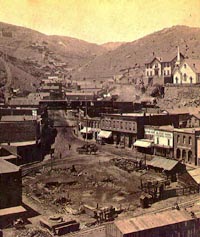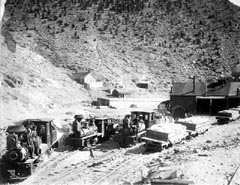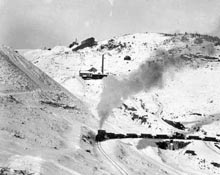The story of the Gilpin Gold Tram starts in April of 1859
when John H Gregory started up Clear Creek from Golden searching for gold.
Gold flakes were being found in the creek, so the question was, where was
the gold coming from. Working up the creek and following the
north branch of Clear Creek at what is now know as Forks (for years, a
station and restaurant, now a traffic light), Gregory found the
richest gold dust in what is now called Gregory Gulch above Black Hawk.
The Gregory Lode had been found.
The news of gold hit the nation. By September, a
population of 900 in log shanties and tents had invaded the valley. By
the summer of 1860 sixty ore mills and thirty arastras (a kind of ore
grinding pit) were in operation and the population had risen to 15,000.
Soon numerous mining camps had sprung up including Black Hawk, Central City,
Nevadaville, Russell Gulch and Apex.
 But by the mid-60s, the easy gold had been mined out.
Gilpin county came on hard times. What was needed was both
better technology in milling, and a means of transporting the ore from mine
to mill and mill to the rest of the world. New technology did
come, with the first smelter being setup in Black Hawk in 1865. As for
transportation, that came in the form of the three foot narrow gauge
Colorado Central. The CCRR was formed in 1870 with construction
starting in September of 1871. Based in Golden Colorado, the
trackage worked it's way up Clear Creek, splitting at Forks with the first
branch going on to Black Hawk. The train arrived in Black Hawk
on December 15, 1873. The mills now had a way to get their
product to Denver and the world beyond. In 1878, a switchback
extension was built the one mile distance from Black Hawk to Central City
with four miles of trackage, and the first train arriving on May 21 1878.
But by the mid-60s, the easy gold had been mined out.
Gilpin county came on hard times. What was needed was both
better technology in milling, and a means of transporting the ore from mine
to mill and mill to the rest of the world. New technology did
come, with the first smelter being setup in Black Hawk in 1865. As for
transportation, that came in the form of the three foot narrow gauge
Colorado Central. The CCRR was formed in 1870 with construction
starting in September of 1871. Based in Golden Colorado, the
trackage worked it's way up Clear Creek, splitting at Forks with the first
branch going on to Black Hawk. The train arrived in Black Hawk
on December 15, 1873. The mills now had a way to get their
product to Denver and the world beyond. In 1878, a switchback
extension was built the one mile distance from Black Hawk to Central City
with four miles of trackage, and the first train arriving on May 21 1878.
The problem still remained on how to economically get the
gold bearing quartz ore down to the mills of Central City and Black Hawk.
It was a dangerous, slow and expensive process to bring the ore down in
horse drawn wagons. In the summer of 1886 five mining men met to
solve the problem. The solution was the Gilpin Tramway Company,
formed on July 29th in Central City by Henry C. Bolsinger, Bradford H.
Locke, Robert A. Campbell, Andrew W. Rogers and Henry J. Hawley. The
purpose of the company was to build a two foot gauge railroad to transport
ore from the mines above Black Hawk to the mills.
 Grading was started in May 1887. A frame barn
was purchased above Black Hawk as an engine house. The first rails
were laid on July 1, 1887. Shay #1 arrived on August 26th, with
it's first run on September 1. Trackage worked it's way back
down Clear Creek climbing the side of the hill and climbing up into Gregory
Gulch. Maximum grade was six percent with several curves having a 50
foot radius! The trackage continued on above Central City (there was
an excursion train for Central City residents from where the tram crossed
Eureka Gulch to Black Hawk on September 29, 1887). From there the
trackage continued up to Nevadaville, Quartz Hill and Russel Gultch.
Grading was started in May 1887. A frame barn
was purchased above Black Hawk as an engine house. The first rails
were laid on July 1, 1887. Shay #1 arrived on August 26th, with
it's first run on September 1. Trackage worked it's way back
down Clear Creek climbing the side of the hill and climbing up into Gregory
Gulch. Maximum grade was six percent with several curves having a 50
foot radius! The trackage continued on above Central City (there was
an excursion train for Central City residents from where the tram crossed
Eureka Gulch to Black Hawk on September 29, 1887). From there the
trackage continued up to Nevadaville, Quartz Hill and Russel Gultch.
Much of the altitude gained by the Gilpin was done by the
use of switchbacks. The Tram had more switchbacks than any other
American railroad. At one point, seven switchbacks were used to
reach a single mine.
The railroad was not without it's opponents. The
Gilpin was in direct competition to the various teamster outfits.
An agreement had been made with the Colorado Central to lay a third rail
through Black Hawk to allow the Gilpin to reach it's various mills and
smelters. Mayer William Fick, associated with many of the
teamsters, fought to stop the Gilpin from coming through 'his' town.
The third rail was laid after various legal actions starting in December
1887. But that was not the end of it, in April 1888, the Mayer
accompanied by the marshal ordered laborers to stop laying the third rail
and to start removing trackage that had already been laid. Fick
declared that the tram would throw teamsters out of work, a great calamity
for the city. But with a payment from the Gilpin of $450
to the city, the Mayor was advised to quit his losing fight, and none of the
trackage was removed.
Ore and supplies were not the only cargo carried on the
Gilpin. On May 23, 1888 the tram received six new excursion
passenger cars. As with many other railroads in the west,
tourist traffic created a good supplement to the railroads income.
Excursions occurred throughout each summer. A round trip from Black
Hawk with lunch was 75 cents. A combined trip on the Colorado
Central from Denver was $2.40.
 Throughout 1888, track was extended to mines and mills
leading to fifteen and a half miles of track by winter of that year.
Once winter arrived, a new and interesting problem arrived as well.
Ore comes from wet ground, and in the winter, it has a tendency to freeze
solid in the cars before delivery to the mills. The tram solved this
problem with a unique solution. A warming house was built near
the engine house with tracks running it's entire length. Steam pipes
and stoves warmed the building to a high of 120 degrees, thus keeping the
ore warm and dry.
Throughout 1888, track was extended to mines and mills
leading to fifteen and a half miles of track by winter of that year.
Once winter arrived, a new and interesting problem arrived as well.
Ore comes from wet ground, and in the winter, it has a tendency to freeze
solid in the cars before delivery to the mills. The tram solved this
problem with a unique solution. A warming house was built near
the engine house with tracks running it's entire length. Steam pipes
and stoves warmed the building to a high of 120 degrees, thus keeping the
ore warm and dry.
Traffic continued to grow throughout the 1890s, with three
Shays taking up the load. Accidents did happen on occasion with
engines jumping the track and rolling over. By 1900, new shays
were replacing the old ones.
In January 1899, the Colorado Central (then owned by the
bankrupt Union Pacific) was taken over by the Colorado and Southern.
The Gilpin had been showing a nice profit in the early 1900's so by 1905,
the C&S was looking at the Gilpin as a likely acquisition. On June 27,
1906, the Gilpin was sold to the Colorado and Southern.
 1910 saw the Gilpin at it's greatest length of 26.46 miles
including spurs and sidings. But unfortunately, the C&S bought the
Gilpin at the height of it's profitability. The profit
margins on mining gold was dropping both due to increased cost to extract
the gold, and fixed prices in the gold market due to government.
As such, traffic was dropping. Soon the Gilpin was running in the red.
The last train ran on January 17, 1917. The railroad was sold
for scrap in June of 1917.
1910 saw the Gilpin at it's greatest length of 26.46 miles
including spurs and sidings. But unfortunately, the C&S bought the
Gilpin at the height of it's profitability. The profit
margins on mining gold was dropping both due to increased cost to extract
the gold, and fixed prices in the gold market due to government.
As such, traffic was dropping. Soon the Gilpin was running in the red.
The last train ran on January 17, 1917. The railroad was sold
for scrap in June of 1917.

